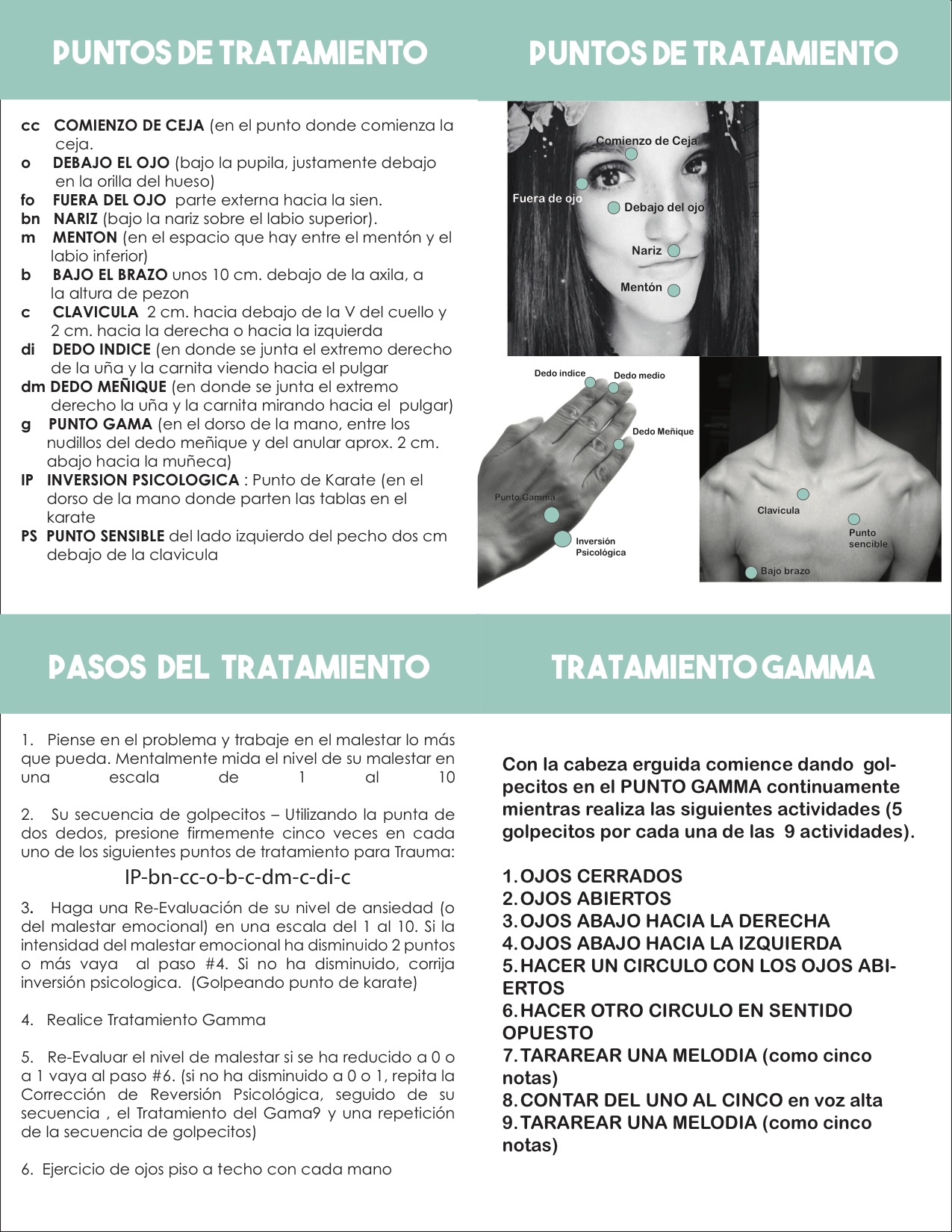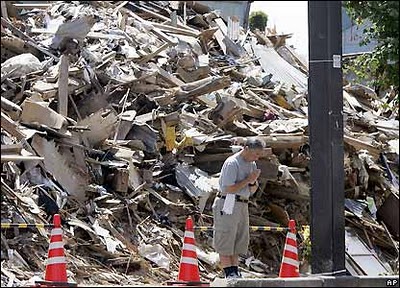Let us help survivors of the earthquake in Mexico deal with its aftermath by reducing the effects of trauma–and pass this on! Thank you, Leonor Zarazua, for this diagram of the simple trauma relief technique.
Tag: earthquake
TFT in Chile with Earthquake and Fire Victims
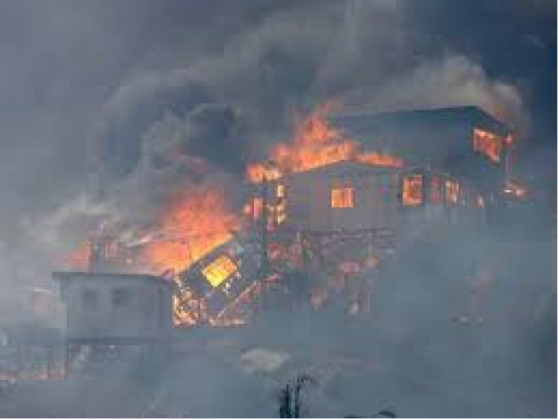
by Mariela Prada, TFT-Adv
As you may know Chile is a country where natural disasters happen every now and then. Thus most people are always willing to help and to assist those in needs when something happens, each one doing its best according to experience and knowledge.
In March we had a “minor” earthquake (7.0) in the northern region (Iquique, a port in the north of Chile) , which was not so harmful but left people in a state of unease and expectation to what might be coming next. On April 1 a much bigger earthquake (8.3) hit the same region at 8 pm. Fortunately most were already at home with their families , which was a very positive. The first reaction people have with these events is to desperately know if their relatives are ok.
It is also important to know that for many weeks there were important aftershocks which kept people under continuous stress . Some did not want to sleep in their homes for fear it would hit again at night, and many wanted to stay in the surrounding hills, as after earthquakes there is always the danger of a tsunami afterwards. The memory of what happened in March 2010 (earthquake plus sumani).
In these cases, the best way to help is to do it through a local organization. A group of TFT therapist were eager to help, so we got in contact with a mining company who was organizing psychological help for people affected by this earthquake. One of the volunteers was somebody who has done the Algorithm course and lives in Iquique.
The team traveled to Iquique twice for one week. Most of the times they worked with a whole group (algorithm for the trauma plus emotions), the only way to give help in larger number. And in some cases , they did individual sessions (using mostly diagnostics).
The work involved the trauma (s) of the situation, plus the anxiety of what the next one to come, as earthquake specialist were saying that not all of the pressure had been released , which means that there must be another one in a near future. This caused a lot of anxiety in all of the people treated, and mainly those who had to drive up to the mines, which means taking a winding road that may be very dangerous during an important earth movement. Thus we also had to address this anxiety and give them tools to do tapping on their own while driving up the road or whenever they felt uneasy or afraid.
While we were doing these interventions, we had another big disaster on April 23. In Valparaiso, a hilly town near the sea there was a huge fire that burned down 2.900 homes affecting 12.500 people, all of them of very low means of income. The fire was extinguished only after a week; the town was covered in smoke, the houses burned to ashes, people living in shelters, stray dogs and cats in need of food….
Local authorities asked to concentrate all help through organizations working in Valparaíso so as to limit the number of people coming to the city. In this case we worked through the School of Psychologist, who had the necessary contacts to go and work with the people, mainly in shelters.
In this case the traumas were not only the one of the fire but also that of losing all their belongings, all their “treasures” (pictures, family items, etc)., the uncertainty of the future (the local government is rebuilding those homes but that takes time), children who had lost their pets, whose school had burned down, plus the daily problems that rise when living in shelters with many other families.
As you can see, it is a multitraumatic situation. In this case, what we mostly did was train volunteers to work with the appropriate algorithm. This work is still being done; volunteers mainly work on week-ends. They have also been trained to teach parents algorithms to have tools to help their children. This empowers them and gives them tools they can use with others.
Once again, TFT has proved to be a wonderful tool to help people in need, help them get over their traumas, to do tapping with their children, to get back the energy to address their daily routines, help them have faith in the future.
Update on TFT for Earthquake Survivors in Japan
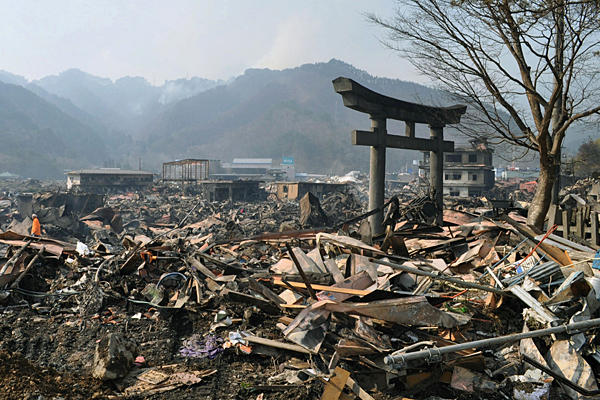 By Ayame Morikawa, Ph.D., TFT-VT, TFT-RCT
By Ayame Morikawa, Ph.D., TFT-VT, TFT-RCT
The Japanese Association for TFT continuously supports the victims in the North of Japan.
We offer workshops in public and cooperate with medical institutes, public offices, and other parties.
The people in the area are very sensitive to the words of “trauma”, “PTSD”or even “Psychological” problems. It may come from our cultural spirit of Chivalry that we should not mar the pleasure or the serenity of another by expression of our sorrow or pain and that we should try to attain our mind level at the highest good.
We as professionals are very careful dealing with their emotions and pride to offer the best support for them.
TFT for Survivors of Japanese Earthquake & Tsunami
ATFT UPdate, Issue 17, Summer 2011
Sudden Destruction in Japan
by Ayame Morikawa, PhD, TFT-VT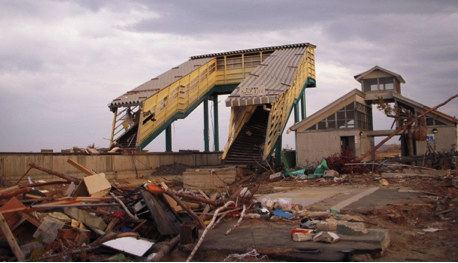
On March 11, 2011, a terrible earthquake and tsunami struck northern Japan. In it’s wake it left 15,019 people dead, 5,282 people injured, and 9,506 people missing as of the time of this report. Approximately 500 kilometers or 311 miles of coastline were affected some of which was totally destroyed. We felt the earthquake in Tokyo as well.
As soon as we were able, our Japan Association For Thought Field Therapy CRT (JATFT), sent two psychiatrists, 2 psychologists (including myself), and 1 nurse to Miyagi National Hospital. The hospital was established in 1939 and has 14 departments but they do not have a psychiatry department. Therefore, our team served as their psychiatry department. The hospital is located in the very south part of Miyagi Prefecture at the border of Fukushima Prefecture. It is located 60 kilometers or roughly 37 miles from the atomic power plant.
The town, Yamamoto-Cho, had approximately 17,000 inhabitants and they lost 900 lives. This town is famous for its strawberry and apple farms. The apple farms are in the mountainous area and they stayed safe, but only 5 strawberry farms were left out of a total of 400 strawberry farms. Most of them were located along the coastline.
Arranging Trauma Care
One of our aims is to support nurses who are working there and those who have lost their families and houses. One of our members, Dr. Nakahara, D.D.S., who works at the hospital is trained at the Diagnostic TFT level. She arranged our schedule and found that a nursing care facility, and a nursing school, around the hospital had lost many old people, workers, and some small children. Continue reading “TFT for Survivors of Japanese Earthquake & Tsunami”
TFT Trauma Training for Survivors of Haiti Earthquake

UPdate Magazine, Issue 16, Autumn 2010
Haiti 2010: TFT Mission to Haiti
By Phyllis Robson, TFT-Adv, and Howard Robson, MD, TFT-Algo
When we heard of the disastrous earthquake that struck Haiti on 12th January 2010, we immediately thought that TFT would have much to offer to the traumatised population following the initial rescue and emergency interventions.
Haiti has a troubled history; It was occupied by European colonists. The native population died out and African slaves were used to replace them.
Plantations and logging provided great economic benefit for the colonists, but at a critical cost to later generations of Haitians. Deforestation caused soil erosion and mudslides. Despite achieving independence over 200 years ago, the country has been marred by violence, instability, poverty and corruption. There is a lack of infrastructure and a susceptibility to hurricanes.
When the opportunity to visit Haiti came later in the year, on behalf of the ATFTFoundation, we were in a position to volunteer. We were to be part of a mission led by Dr. Jean-Murat Carolle (Angels for Haiti), which was part of a larger medical mission led by Dr Charles René.
We immediately thereafter began collecting supplies for the visit, especially as part of the project was to enable the children to express themselves through arts. These supplies included pens, paints, brushes, books and paper, as well as some medical and dental supplies and toiletries.
We were particularly grateful for the help of our dentist and family and friends. We were also grateful for the provision of the TFT algorithm manual in French from Suzanne Connolly, which we modified slightly for the local requirements, and printed sufficient copies for our expected training sessions. We managed to obtain a reasonable rate from the airlines for our considerable luggage excess.
Essential to visiting a country such as Haiti is to understand the local culture and attend to personal safety and health (vaccinations and anti-malarial drugs). We attended to these issues as much as possible, to maximise our contribution to the mission and not be a burden.
We left home in the early hours of 1st July, 2010, via Newcastle, London, Miami and Port-au Prince for La Vallee de Jacmel in Haiti. La Vallee is a mountain village serving a rural population in southern Haiti, 11 miles from the coastal city of Jacmel. The primary occupation is farming; there is economic hardship, and lack of resources and infrastructure.
Although some distance from the epi-centre of the earthquake, there had been ten deaths within the region of La Vallee Jacmel which also had suffered considerable structural damage. The experience of the earthquake and after-shocks had affected many local people. There had also been an influx of people from more affected areas. These people had lost homes, possessions and whole Continue reading “TFT Trauma Training for Survivors of Haiti Earthquake”
Relieving Trauma from Earthquake in Japan
We have instructions for the TFT trauma relief technique in Japanese. Go to the page listed on the right that says “Japanese”. It will give a link to the ATFT association website in Japan, which has complete instructions in Japanese. Please pass this on to those you know in Japan. It can greatly relieve the suffering involved in such a crisis.
If you need any assistance with this, please let us know by submitting a comment. We’ll get back to you as soon as possible.

